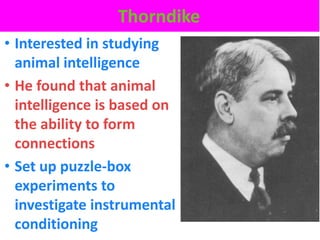Trial & error learning Thorndike - VCE U4 Psych
•Als PPTX, PDF herunterladen•
33 gefällt mir•41,071 views
This 4 slide file accompanies a youtube clip (see www.ePsychVCE.com to access link to clip). It covers Thorndike's Puzzle box experiment an his infamous 'law of effect'
Melden
Teilen
Melden
Teilen

Empfohlen
Empfohlen
Weitere ähnliche Inhalte
Was ist angesagt?
Was ist angesagt? (20)
Process of Learning and Factors affecting learning – Nature of the learner, n...

Process of Learning and Factors affecting learning – Nature of the learner, n...
Ähnlich wie Trial & error learning Thorndike - VCE U4 Psych
Ähnlich wie Trial & error learning Thorndike - VCE U4 Psych (20)
Edward Thorndike law of effect, Theory of Learning, Trial and Error theory

Edward Thorndike law of effect, Theory of Learning, Trial and Error theory
Animal behaviour and types of animal behavior power point presentation

Animal behaviour and types of animal behavior power point presentation
Learning pshychology faculty of physiotherapy.pptx

Learning pshychology faculty of physiotherapy.pptx
Skinner Operant conditioning | Thorndike trial and error learning 

Skinner Operant conditioning | Thorndike trial and error learning
UNITS TWO APPROACES 1 BEHAVIOURISM (1) [Autosaved].pptx![UNITS TWO APPROACES 1 BEHAVIOURISM (1) [Autosaved].pptx](data:image/gif;base64,R0lGODlhAQABAIAAAAAAAP///yH5BAEAAAAALAAAAAABAAEAAAIBRAA7)
![UNITS TWO APPROACES 1 BEHAVIOURISM (1) [Autosaved].pptx](data:image/gif;base64,R0lGODlhAQABAIAAAAAAAP///yH5BAEAAAAALAAAAAABAAEAAAIBRAA7)
UNITS TWO APPROACES 1 BEHAVIOURISM (1) [Autosaved].pptx
Mehr von Andrew Scott
Mehr von Andrew Scott (18)
VCE U4 Psychology - Brain mechanisms involved in learning

VCE U4 Psychology - Brain mechanisms involved in learning
Trial & error learning Thorndike - VCE U4 Psych
- 1. Thorndike • Interested in studying animal intelligence • He found that animal intelligence is based on the ability to form connections • Set up puzzle-box experiments to investigate instrumental conditioning
- 2. Trial & Error learning - Thorndike • Describes an organism’s attempts to learn/solve a problem by trying alternative possibilities until a correct solution or desirable outcome is achieved Usually involves 1. A number of attempts & a number of errors - Before correct behaviour is learnt 2. Motivation (to achieve a goal) 3. Exploration – either random or purposeful 4. Reward – the correct response is rewarded – • which will lead to repeat performance of the correct response, strengthening the association between the behaviour & its outcome • Once learnt behaviour will usually be performed quickly and with fewer errors
- 3. Thorndike’s Puzzle-box experiment • Thorndike put a hungry cat in a ‘puzzle box’ & placed fish, just out of reach 1. At first the cat to escape from the box through trial & error (random voluntary movements) 2. Eventually the cat accidentally pulled the string, escaped from the box so that it could reach its reinforcement (the fish) • When the cat was put back in the box, once again it went through a series of incorrect responses before pushing the lever • The cat became progressively quicker at escaping (and had fewer incorrect behaviours)
- 4. Thorndike ‘Law of Effect’ • Thorndike concluded that the cat had learned the association between its behaviour (pulling the string) & the consequences (reaching the food) • Results led Thorndike to devise the ‘Law of effect’ that is a behaviour that is followed by a satisfying consequence is strengthened (more likely to happen) than a behaviour that is followed by an annoying consequence which is weakened (less likely to occur) • The food was a satisfying consequence – hence the cat would try to escape • Behaviour that kept the cat in the box (annoying consequence) was less likely to occur
